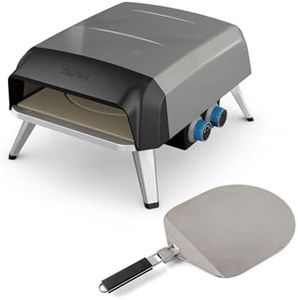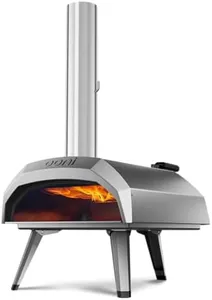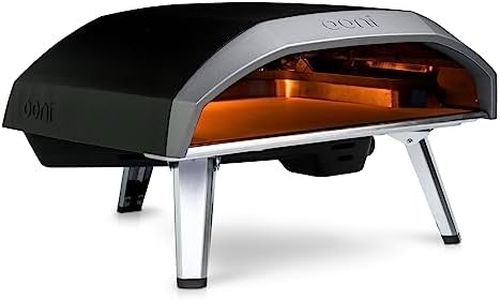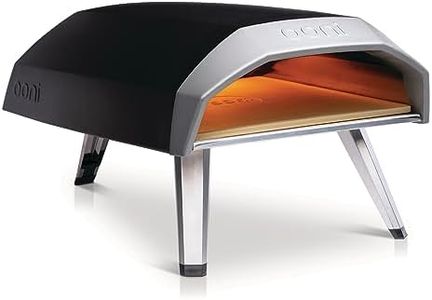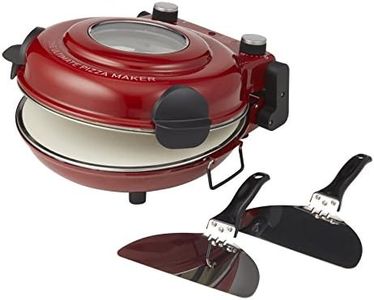We Use CookiesWe use cookies to enhance the security, performance,
functionality and for analytical and promotional activities. By continuing to browse this site you
are agreeing to our privacy policy
6 Best Propane Pizza Ovens
From leading brands and best sellers available on the web.Buying Guide for the Best Propane Pizza Ovens
Choosing a propane pizza oven can greatly enhance your home-cooking experience by giving you the ability to make crispy, delicious pizzas with that authentic pizzeria flavor. To find the oven that fits you best, it's important to consider how often you plan to use it, where you’ll place it (outdoors is most common), and how many people you'll typically cook for. Looking closely at the oven's features and key specifications will help you make a choice that leads to great pizzas and easy cooking.Cooking Surface SizeCooking surface size refers to the area available for placing your pizza inside the oven. This matters because it determines the maximum pizza size you can make in one go. Ovens usually vary from small (10-12 inches) to large (14 inches and above). If you usually cook for just one or two people, a smaller surface can be more than enough and easier to handle. If you plan to entertain or have a larger family, a bigger surface lets you cook larger pizzas or multiple smaller ones at once.
Maximum TemperatureMaximum temperature shows how hot the oven can get at its highest setting. This is important because authentic pizza—especially Neapolitan style—bakes best at high temperatures, usually between 700°F and 900°F. Ovens with lower maximum temperatures (below 600°F) may take longer and not quite replicate that crispy crust. For most home cooks, an oven that reaches at least 700°F is best for faster, even cooking; if you love extra-charred, restaurant-style pizzas, opt for the higher end of the temperature range.
Heat-Up TimeHeat-up time is how quickly the oven reaches cooking temperature once it’s turned on. This spec matters if you value convenience or want to make pizza quickly on busy days or during parties. Some ovens can be ready in as little as 10-15 minutes, while others might take 30 minutes or more. If your goal is fast, spontaneous pizza nights, look for a model with a shorter heat-up time. If you don’t mind waiting or usually plan ahead, a longer heat-up time isn’t a big deal.
Construction MaterialThe materials used in the oven's build—like stainless steel, ceramic, or stone—affect heat retention, durability, and sometimes the final pizza result. Stainless steel is common and offers good durability, quick heating, and easy cleaning. Stone or cordierite decks retain heat well for crispier bases but may need a bit more care. If you want an oven that heats and cools quickly and is easy to maintain, stainless is a solid choice. For the best pizza crust, though, some users might prefer a stone deck.
PortabilityPortability refers to how easy it is to move the oven around, which depends on its weight, size, and whether it has handles or collapsible legs. This matters if you need to store the oven after use, travel with it, or have limited outdoor space. Lightweight, compact ovens are easy to move and store, while heavier ones may be sturdier but less portable. Decide if your oven will have a permanent home outdoors or if you’ll want to bring it camping or to parties—your answer will guide you here.
Gas ConnectivityThis spec details how the oven connects to the propane source—usually a standard propane tank. It’s important because ease of connection and compatibility with tanks determines setup simplicity and how easily you can move or refill your oven. Most portable propane ovens connect to standard tanks, but some use smaller canisters for added mobility. Think about where and how you’ll use the oven: for home use, standard tank compatibility is usually best, but for travel, a model that connects to small cylinders may suit you better.
Ease of CleaningEase of cleaning describes how simple it is to keep the oven tidy, which depends on features like removable trays or crumb catchers, and the material of the cooking deck. An oven that’s easy to clean will save you time and prevent build-up that could affect your food. If you plan to use the oven frequently or don’t want to spend long on maintenance, check for features like detachable parts or non-stick interiors.

